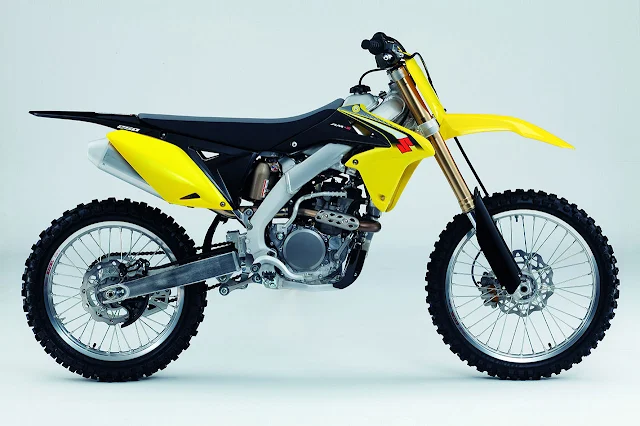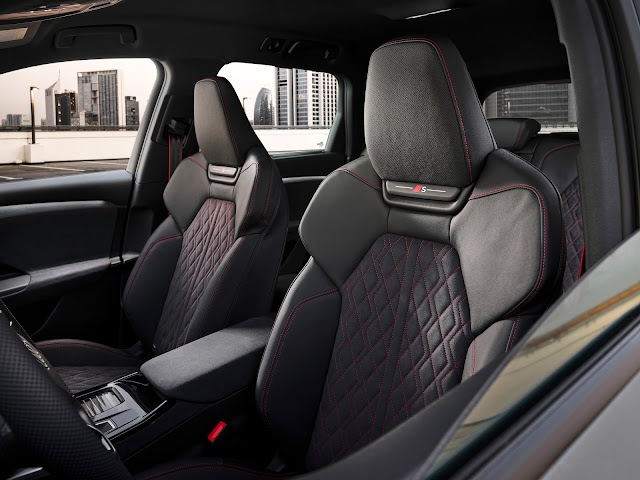Suzuki RM-Z250 Motorcycle
The new RM-Z250 has been designed in conjunction with the factory's race teams in Europe and the United States to build on the existing bike's strong platform, continuing Suzuki's pursuit of the perfect MX2 class motocross machine. The new RM-Z has a broader spread of power, lighter chassis, increased durability, and improved handling performance.
Suzuki has announced details of its new 2016 RM-Z250, which features a Holeshot Assist Control system as well as new suspension, a lighter, redesigned frame, new brakes, and new engine components.
Suzuki Holeshot Assist Control
Suzuki's Holeshot Assist Control (S-HAC) system is derived straight from the factory's race bikes and was first introduced on the RM-Z450 last year, and is now featured on the new RM-Z250, designed to help riders get the best possible launch from the gate. However, the system has been further developed and advanced for 2016, and works to deliver optimum power and drive during the bike's initial launch from the gate and acceleration to the first corner.
Developed with Clement Desalle and the Rockstar Energy Suzuki team, the system boasts two selectable modes and alters the bike's ignition map for a quicker launch. In A-mode - for use on hard surfaces or conditions with less grip - the system retards the bikes ignition for a smoother launch and reduces wheel spin when riding over the gate. Once out of the gate and into the 'acceleration zone' the ignition timing is advanced for stronger acceleration up to the first corner.
When conditions on the line provide better traction riders should select B-mode, which advances the ignition timing to allow for increased throttle response and stronger acceleration out of the gate. However, the level of ignition advancement is optimised for each of the three areas of the launch, from initial launch, clearing the gate, and acceleration to the first corner.
To select A-mode, hold down the S-HAC switch on the left handlebar for more than 0.7 seconds. The indicator light will start flashing to show the system is in A-mode. To select B-mode, hold the button for more than 1.8 seconds until the light starts flashing faster. After six seconds, when fourth gear is selected, or the throttle is shut, ignition is returned to normal in both modes.
Engine
More than 80 engine components are new or redesigned for the 2016 RM-Z250 with the aim of improving the bike's engine performance and providing a wider spread of power throughout the rev range, but also to reduce engine braking force and improve starting.
Both intake and exhaust camshafts are changed for more flexible engine performance, with intake valves redesigned to increase compression ratio and increase intake efficiency. As a result, compression ratio is changed from 13.5:1 to 13.75:1 and the new RM-Z250 benefits from a wider spread of power and a smoother power delivery.
The cam-chain tensioner is now teflon-coated to reduce friction and increase durability. A new tensioner adjuster provides more adjustability. Piston, piston pin and piston ring durability is also increased, with the piston benefiting from shot peening surface treatment. The pin gets a diamond-like carbon coating for less friction, while the ring is now L-shaped to increase sealing performance and reduce blow-by gas. All these changes add up to increased reliability and the wider spread of power.
Engineers have also reduced crank inertia and increased the magneto inertia to reduce engine-braking force when riders close the throttle. Crankshaft inertia weight is reduced and magneto rotor inertia weight is increased to hold the balance from the reduced crank weight. The crankcase is also redesigned for greater oil lubrication. The reed valve is thinner than the previous model’s for better oil circulation, and again helps to reduce engine-braking force. The increase in the throttle valve idle-set angle also contributes to the reduced engine braking effect, with the angle increased from 0.6 degree to 1.1 degree.
A redesigned kick drive gear is larger than the previous RM-Z250's and increases the crankshaft's rotating efficiency, while the kick idle gear is relocated and a breather gear has been added for more efficient starting. The decompression system has also been changed for a more precise operation, and the working angle is smaller and the return spring relocated. As a result, the system works more precisely and more efficient decompression is enabled. In doing so the need for a hot-starter system has been removed.
The 2016 RM-Z250's enhanced mid-range power and torque hasn't come at the expense of top-end power, with maximum output maintained from the existing model. The delivery of the new machine's power is smoother and more linear.
The rich / lean couplers introduced on the previous RM-Z250 remain, and can be used to quickly adjust the bike's fuelling to suit the riding conditions.
Suspension
Braking and cornering performance is dramatically improved with the addition of new, second generation KYB pneumatic spring front forks, which are also 1kg lighter than the current model's front forks.
With traditional coil spring forks, riders must change from softer or harder springs depending on weight, skill level or riding style. With the new PSF2 forks, spring rates are changed with an air pump, which means changes suspension setup changes can be made quicker and easier.
In addition to the spring settings, rebound damping is now two-way adjustable for high and low speed. Damper performance is also increased by a larger damper cylinder, thanks to the removal of the coil spring. It results in a greater damper response and more stable performance.
Suspension performance is also increased with a new KYB rear shock, which also offers high and low speed rebound damping adjustability. There's easy access to the shock's adjusters, with new cush rod spacers for a better feeling from the rear.
Chassis
The new RM-Z250 has an updated frame that shaves 2.5% off the weight of the previous model's. This is achieved through a new steering head, a new rib structure on the inside of the frame's pivot points, while the lower connection to the engine cradle is redesigned too. All of the changes reduce weight but also optimise the chassis rigidity, and in turn increase cornering performance.
Weight is also reduced in the braking department, with a new front caliper that is 10% lighter than the one it replaces. Stopping power is maintained.
A Renthal aluminium Fatbar is standard, and has more strength and less vibration than aluminium straight bars. Excel aluminium rims are shod with new Dunlop MX52 tyres, which adds a softer compound rear tyre sidewall to achieve a better absorption feel.
Availability
The new RM-Z250 is expected to arrive in authorised Suzuki dealerships in August, 2015.
Suzuki Press
Suzuki has announced details of its new 2016 RM-Z250, which features a Holeshot Assist Control system as well as new suspension, a lighter, redesigned frame, new brakes, and new engine components.
Suzuki Holeshot Assist Control
Suzuki's Holeshot Assist Control (S-HAC) system is derived straight from the factory's race bikes and was first introduced on the RM-Z450 last year, and is now featured on the new RM-Z250, designed to help riders get the best possible launch from the gate. However, the system has been further developed and advanced for 2016, and works to deliver optimum power and drive during the bike's initial launch from the gate and acceleration to the first corner.
Developed with Clement Desalle and the Rockstar Energy Suzuki team, the system boasts two selectable modes and alters the bike's ignition map for a quicker launch. In A-mode - for use on hard surfaces or conditions with less grip - the system retards the bikes ignition for a smoother launch and reduces wheel spin when riding over the gate. Once out of the gate and into the 'acceleration zone' the ignition timing is advanced for stronger acceleration up to the first corner.
When conditions on the line provide better traction riders should select B-mode, which advances the ignition timing to allow for increased throttle response and stronger acceleration out of the gate. However, the level of ignition advancement is optimised for each of the three areas of the launch, from initial launch, clearing the gate, and acceleration to the first corner.
To select A-mode, hold down the S-HAC switch on the left handlebar for more than 0.7 seconds. The indicator light will start flashing to show the system is in A-mode. To select B-mode, hold the button for more than 1.8 seconds until the light starts flashing faster. After six seconds, when fourth gear is selected, or the throttle is shut, ignition is returned to normal in both modes.
Engine
More than 80 engine components are new or redesigned for the 2016 RM-Z250 with the aim of improving the bike's engine performance and providing a wider spread of power throughout the rev range, but also to reduce engine braking force and improve starting.
Both intake and exhaust camshafts are changed for more flexible engine performance, with intake valves redesigned to increase compression ratio and increase intake efficiency. As a result, compression ratio is changed from 13.5:1 to 13.75:1 and the new RM-Z250 benefits from a wider spread of power and a smoother power delivery.
The cam-chain tensioner is now teflon-coated to reduce friction and increase durability. A new tensioner adjuster provides more adjustability. Piston, piston pin and piston ring durability is also increased, with the piston benefiting from shot peening surface treatment. The pin gets a diamond-like carbon coating for less friction, while the ring is now L-shaped to increase sealing performance and reduce blow-by gas. All these changes add up to increased reliability and the wider spread of power.
Engineers have also reduced crank inertia and increased the magneto inertia to reduce engine-braking force when riders close the throttle. Crankshaft inertia weight is reduced and magneto rotor inertia weight is increased to hold the balance from the reduced crank weight. The crankcase is also redesigned for greater oil lubrication. The reed valve is thinner than the previous model’s for better oil circulation, and again helps to reduce engine-braking force. The increase in the throttle valve idle-set angle also contributes to the reduced engine braking effect, with the angle increased from 0.6 degree to 1.1 degree.
A redesigned kick drive gear is larger than the previous RM-Z250's and increases the crankshaft's rotating efficiency, while the kick idle gear is relocated and a breather gear has been added for more efficient starting. The decompression system has also been changed for a more precise operation, and the working angle is smaller and the return spring relocated. As a result, the system works more precisely and more efficient decompression is enabled. In doing so the need for a hot-starter system has been removed.
The 2016 RM-Z250's enhanced mid-range power and torque hasn't come at the expense of top-end power, with maximum output maintained from the existing model. The delivery of the new machine's power is smoother and more linear.
The rich / lean couplers introduced on the previous RM-Z250 remain, and can be used to quickly adjust the bike's fuelling to suit the riding conditions.
Suspension
Braking and cornering performance is dramatically improved with the addition of new, second generation KYB pneumatic spring front forks, which are also 1kg lighter than the current model's front forks.
With traditional coil spring forks, riders must change from softer or harder springs depending on weight, skill level or riding style. With the new PSF2 forks, spring rates are changed with an air pump, which means changes suspension setup changes can be made quicker and easier.
In addition to the spring settings, rebound damping is now two-way adjustable for high and low speed. Damper performance is also increased by a larger damper cylinder, thanks to the removal of the coil spring. It results in a greater damper response and more stable performance.
Suspension performance is also increased with a new KYB rear shock, which also offers high and low speed rebound damping adjustability. There's easy access to the shock's adjusters, with new cush rod spacers for a better feeling from the rear.
Chassis
The new RM-Z250 has an updated frame that shaves 2.5% off the weight of the previous model's. This is achieved through a new steering head, a new rib structure on the inside of the frame's pivot points, while the lower connection to the engine cradle is redesigned too. All of the changes reduce weight but also optimise the chassis rigidity, and in turn increase cornering performance.
Weight is also reduced in the braking department, with a new front caliper that is 10% lighter than the one it replaces. Stopping power is maintained.
A Renthal aluminium Fatbar is standard, and has more strength and less vibration than aluminium straight bars. Excel aluminium rims are shod with new Dunlop MX52 tyres, which adds a softer compound rear tyre sidewall to achieve a better absorption feel.
Availability
The new RM-Z250 is expected to arrive in authorised Suzuki dealerships in August, 2015.
Suzuki Press








Comments
Post a Comment